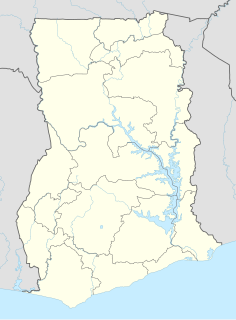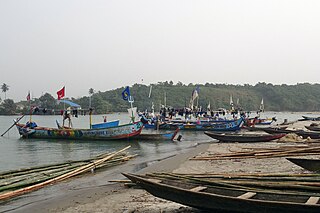
Koforidua, also popularly known as K-dua or Kofcity, is a city and the capital of Eastern Region in southern Ghana. Koforidua was founded in 1875 by migrants from Ashanti. It is also called New Juaben. The city has a settlement city proper population of 183,727 people as of 2010, Koforidua is an amalgamation of two Municipalities; New Juaben North and South. The city has a blend of colonial and modern architecture.

Goaso is a town and it's the capital of the newly created Ahafo Region of Ghana. Goaso doubles as the capital of Asunafo North Municipal District. It is located between three major towns; Mim, Kukuom and Hwidiem. Other surrounding towns include Ayumso, Akrodie, Fawohoyeden and Nkaseim. Goaso has a 2017 estimated population of 24,846 making it the 2nd largest town after Mim in the Asunafo North Municipal District. Goaso is home to the offices of certain government agencies and institutions.

Sefwi-Wiawso Municipal District is one of the nine districts in Western North Region, Ghana. Originally created as an ordinary district assembly in 1988 when it was known as Sefwi-Wiawso District, until the southwest part of the district was split off to create Sefwi-Akontombra District on 29 February 2008; thus the remaining part has been retained as Sefwi-Wiawso District, which it was later elevated to municipal district assembly status on March 2012 to become Sefwi-Wiawso Municipal District. The municipality is located in the northeast part of Western North Region and has Wiawso as its capital town.
The Sefwi are an Akan people.
Paul Evans Aidoo is a Ghanaian teacher and politician. He is the Member of Parliament for Sefwi-Wiawso and is the Minister for the Western Region of Ghana. Prior to heading the Western Region, he was the Brong-Ahafo Regional Minister. He has been condemned for "promoting hatred" by Ghana's Centre for Popular Education and Human Rights after the minister urged people to report suspected homosexuals. "All efforts are being made to get rid of these people in the society," he said.
The environmental impact of cocoa consumers includes deforestation, soil contamination, and herbicide resistance. The majority of cocoa farms are now located in Côte d'Ivoire and Ghana.
The Wiawso College of Education is a teacher education college in the Sefwi-Wiawso District, Western North Region, Ghana. The college participated in the DFID-funded T-TEL programme. It is affiliated to the University of Education, Winneba.
Kwawkrom is a community in the Bibiani-Anhwiaso-Bekwai Western Region of Ghana. It is a rain forest reserve situated near the Boin Tano Nature Reserve. It is approximately 20 kilometers South West of BiBiani.
The Sefwi Wiawso Senior High School is co-ed second cycle educational institution in Sefwi Wiaso in the Western North Region of Ghana.

Bia West is one of the constituencies represented in the Parliament of Ghana. It elects one Member of Parliament (MP) by the first past the post system of election. Bia West is located in the Bia District of the Western North Region of Ghana.

Bia East is one of the constituencies represented in the Parliament of Ghana. It elects one Member of Parliament (MP) by the first past the post system of election. Bia East is located in the Bia East District of the Western North Region of Ghana.

Juaboso District is one of the nine districts in Western North Region, Ghana. Originally it was formerly part of the then-larger Juaboso-Bodi District on August 2004, which was created from the former Sefwi-Bibiani District Council, until the southeast part of the district was split off to create Bodi District on 28 June 2012; thus the remaining part has been renamed as Juaboso District. The district assembly is located in the northwest part of Western North Region and has Juaboso as its capital town.

The Western North Region is one of the six new regions of Ghana created in 2019. The region is bounded by the Ivory Coast on the west, the Central region in the southeast, and the Ashanti, Ahafo, Bono East and Bono regions in the north. The Western North Region has the highest rainfall in Ghana, lush green hills, and fertile soils. There are numerous small and large-scale gold mines companies in the region. The ethnic culture of the region is dominated by the Sefwis. The main languages spoken are Sefwi, Akan, French and English.
Okogyeabour Nkuah Okomdom II was a traditional ruler and Paramount Chief of the Sefwi Wiawso Traditional Area in the Western Region of Ghana from 1997 to 2011.
Joseph Ampah Kojo Essel was a Ghanaian Member of Parliament for the Dompim constituency from 1965 to 1966.
Alluolue Festival is a Ghanaian annual festival celebrated by the chiefs and people of Sefwi Wiawso and Sefwi Bekwai in the Western North region, formally Western region of Ghana. It is usually celebrated in the month of July. Others also claim it is celebrated in November/December.
Isaac Kobina Nyame-Ofori is a Ghanaian politician, farmer and a member of the 3rd parliament of the 4th republic of Ghana. He is a former member of Parliament for the Sefwi-Wiawso constituency in the Western Region a member of the National Democratic Congress political party in Ghana.

Mim is a town in the Asunafo North Municipal District in the Ahafo Region of Ghana. It is a nodal town which connects two regional capitals: Sunyani and Goaso via the N12 Highway. The distance from Mim to Sunyani is 64km while that of Mim to Goaso is 14km. Mim also has direct routes to district capitals such as: Kenyasi to the east; Dormaa Ahenkro to the northwest, Nkrankwanta to Southwest, and Sefwi Debiso to the south. Mim is known for producing timber,cocoa and cashew. The estimated population of Mim in 2017 was 30,753 making it the largest town in Ahafo Region and that of Asunafo North Municipal District. . ..

Mim Bour or Mim Mountains are located 4 kilometres (2.5 mi) to the west of Mim in Asunafo North Municipal District in the Ahafo region of Ghana.

Sefwi Debiso is a town in the Bia West District in the Western North Region of Ghana. It is a central town located between three major towns: Essam, Sefwi Adabokrom and Adwuofua. Because of rapid expanssion, Debiso has conurbated with the nearby Community Essam, which is the Bia West District capital. Sefwi Debiso also has direct distant routes to Mim Ahafo to the north, Sefwi-Wiawso to the east and Ivory Coast to the south. Debiso is known for producing cocoa and timber. Debiso is noted for the Bia National Park.
























